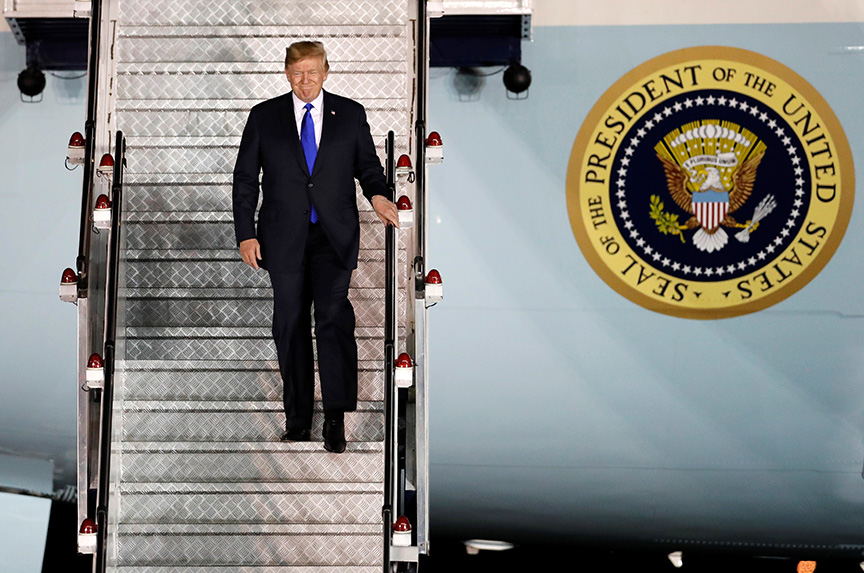 US President Donald J. Trump will meet North Korean leader Kim Jong-un in Singapore on June 12. Atlantic Council analysts present their views on what they believe to be an achievable, best-case outcome, one that would test North Korea’s readiness for genuine, rapid denuclearization by demanding front-loaded “down payments” during the first twelve months.
US President Donald J. Trump will meet North Korean leader Kim Jong-un in Singapore on June 12. Atlantic Council analysts present their views on what they believe to be an achievable, best-case outcome, one that would test North Korea’s readiness for genuine, rapid denuclearization by demanding front-loaded “down payments” during the first twelve months.
Possible North Korean Commitments
North Korea, formally known as the Democratic People’s Republic of Korea or DPRK, will make an overarching commitment to complete, verifiable, and irreversible denuclearization (CVID) within (24)(30)(36) months, to encompass:
- Eliminating all nuclear weapons, ballistic missile delivery systems and launch installations, fissile material production facilities, and test sites.
- Rejoining the nuclear Non-Proliferation Treaty (NPT) as a non-nuclear weapon state and adopting the Additional Protocol, which provides additional tools for verification.
- In addition, the DPRK could affirm that it does not hold chemical or biological weapons (CBW) and pledges not to do so.
The DPRK could also pledge to abide by the United Nations’ Universal Declaration on Human Rights.
As initial steps, within the first twelve months, the DPRK agrees to:
- Maintain its freeze on tests of nuclear weapons and ballistic missiles, with no exception for space launches.
- As a confidence-building measure, within the first three months, remove five intercontinental ballistic missile (ICBM) boosters and ten nuclear warheads to a third country.
- Provide a full inventory of all its nuclear weapons, programs, and facilities, to be verified by the International Atomic Energy Agency (IAEA) and subject to “any time, any place” challenge inspections. (There could be similar challenge inspections to verify a possible pledge on CBW.)
- Take all ICBMs and medium-range ballistic missiles (MRBMs) off line and disable them, to be verified by the Missile Technology Control Regime member states.
- Make a data declaration of deployed short-range rockets and artillery pieces near the demilitarized zone (DMZ) and agree to pull back those systems to ranges away from Seoul.
- Declare and close all tunnels that penetrate South Korea territory.
- Acknowledge that it had, in the past, illegally abducted Japanese and South Korean citizens and promise never to do it again.
Possible US and South Korean Commitments
The United States and South Korea will make an overarching commitment to respect the sovereignty and independence of the DPRK, to refrain from any actions that could undermine the regime, to co-exist peacefully, and to take steps to normalize diplomatic relations, to include the eventual opening of embassies, and to encourage foreign direct investment in the DPRK.
The United States would confirm that it will not deploy nuclear weapons on the Korean Peninsula, and South Korea (formally known as the Republic of Korea or the ROK) would affirm that it will not receive or deploy nuclear weapons, as it pledged in the 1992 North-South Declaration.
The United States and the ROK (along with China) would declare their intention, once denuclearization is underway, to sign a peace treaty with the DPRK ending the Korean War, and providing for balanced ROK and DPRK conventional force reductions and confidence-building measures along both sides of the DMZ.
Within the first twelve months, upon verification that the DPRK has begun implementing the initial steps (described above):
- The United States would declare that it has no intention of attacking or invading the DPRK using conventional or nuclear weapons, assuming full DPRK implementation of all its commitments.
- The United States would support a suspension of UN sanctions and the expansion of humanitarian food and energy assistance to the DPRK.
- The ROK would make a declaration of and pull back its short-range missiles and artillery from the DMZ, reciprocal to the DPRK’s measures above.
- The United States and the DPRK would open Diplomatic Liaison Offices in Pyongyang and Washington.
- The United States would facilitate the DPRK’s accession to the International Monetary Fund, the World Bank, the Asian Development Bank, and the World Trade Organization.
Following the completion of verifiable and irreversible denuclearization at the end of (24)(30)(36) months, the United States and the ROK would:
- Sign the peace treaty, complete implementation of confidence-building measures and conventional force reductions.
- Lift all foreign policy and national security sanctions and, with China, Russia, and Japan, provide economic investment, energy and infrastructure assistance to the DPRK, subject to the DPRK’s establishment of a favorable investment climate consistent with international standards.
Image: US President Donald J. Trump arrives at Paya Lebar Air Base in Singapore on June 10 ahead of a summit with North Korean leader Kim Jong-un on June 12. (Reuters/Kim Kyung-Hoon)
